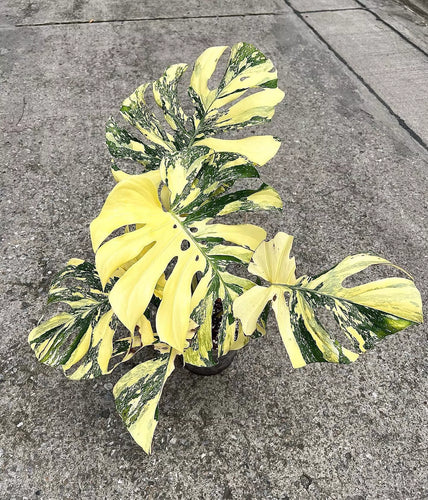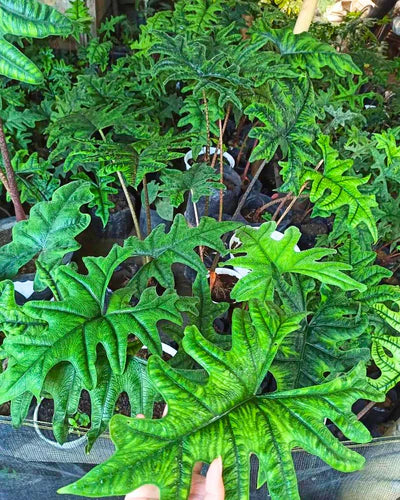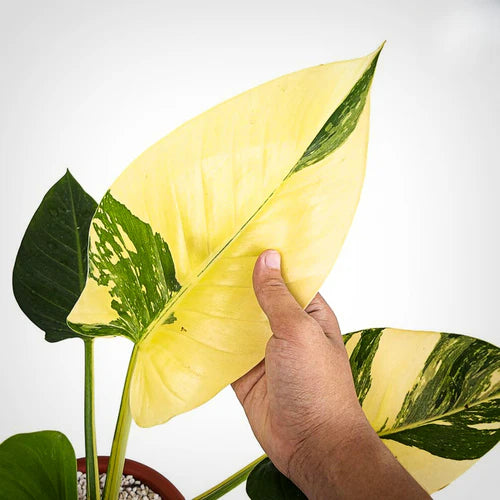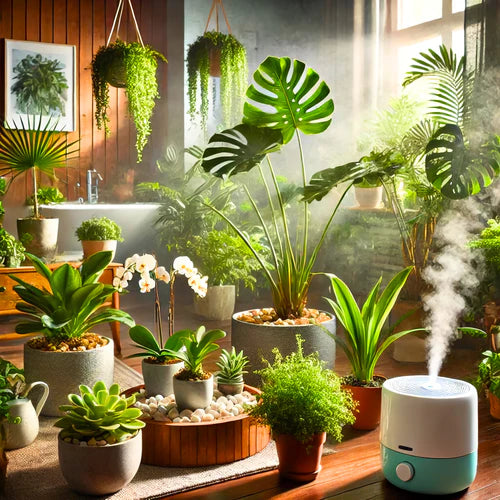How to Grow and Care For Your Rare Pink Princess Marble Galaxy Houseplant

How to Care and Grow Your Rare Pink Princess Marble Galaxy Plant
Introduction
When it comes to the world of indoor houseplants, the Pink Princess Marble Galaxy stands out as captivating tropical plant that has gained popularity among plant enthusiasts. These plants are known for their stunning pink foliage, but a closer look reveals distinct differences that set them apart from the regular pink princess. In this article, we will delve into the unique characteristics of both the Pink Princess and Pink Princess Marble Galaxy plants, exploring their origins, growth patterns, and care requirements.
Unveiling the Pink Princess
Origins and Background
The Pink Princess, scientifically known as Philodendron erubescens, is a tropical plant native to South America. Its mesmerizing pink leaves, adorned with splashes of green, make it a sought-after choice for indoor gardening. This philodendron variety has gained a reputation for its striking appearance and relatively manageable care needs.
Characteristics
Foliage
One of the defining features of the Pink Princess is its predominantly pink foliage. The intensity of the pink hue can vary, ranging from soft blush tones to vibrant shades that almost resemble a painter's palette. The leaves are often variegated with splashes of white or lighter green, adding to the plant's overall allure.
Growth Pattern
The Pink Princess is a vining plant that can gracefully trail or climb with the support of a stake or trellis using it's aerial roots to hold it up. As it matures, the vines may develop a trailing habit, making it an ideal choice for hanging baskets or tall planters. Its growth rate is moderate, and regular pruning can encourage bushier growth and enhance the plant's aesthetic appeal.
Light and Water Requirements
To thrive, the Pink Princess prefers bright, indirect light. While it can tolerate lower light conditions, its vibrant foliage tends to flourish in a well-lit environment. When it comes to watering, it's essential to allow the soil to dry out slightly between waterings, preventing overwatering that can lead to root rot. Depending on your soil medium, we recommend at least the top two inches.
Unraveling the Mystery of Pink Princess Marble

What Sets Pink Princess Marble Apart?
While the Pink Princess Marble shares the same captivating pink coloration as its counterpart, it introduces a distinct and magical marbled pattern that adds a touch of complexity to its appearance.
Characteristics
Marbled Foliage
The Pink Princess Marble, scientifically categorized as Philodendron erubescens 'Marble,' features leaves with a marbled pattern. This pattern consists of intricate swirls of pink and green, resembling a delicate dance between colors that are scattered across the night sky. The marbled effect is a result of genetic variations and adds a layer of uniqueness to each leaf.
Growth Habit
Similar to the Pink Princess, the Pink Princess Marble exhibits a vining growth habit. However, the marbled variety may display a more compact growth pattern, with smaller leaves compared to its counterpart. This can make it an excellent choice for those with limited space or those looking to create lush arrangements in smaller containers. However, if you are wanting bigger leaves, we recommend giving it something to climb.
Care Considerations
The care requirements for the Pink Princess Marble align closely with those of the Pink Princess. Adequate lighting, well-draining soil, healthy fertilization and a balanced watering routine are crucial for maintaining the health and vibrancy of this unique philodendron.
Choosing Between Pink Princess and Pink Princess Marble
Factors to Consider
Now that we've explored the distinctive features of both plants, the choice between Pink Princess and Pink Princess Marble depends on individual preferences and specific care considerations.
Aesthetic Preferences
If you are drawn to bold, solid colors with occasional variegation, the Pink Princess might be the perfect fit. On the other hand, if you appreciate the intricacy of marbled patterns and a slightly more compact growth habit, the Pink Princess Marble could be the ideal choice.
Space and Lighting
Consider the available space and lighting conditions in your home. The Pink Princess Marble, with its potentially more compact growth, might be better suited for smaller spaces or areas with lower light levels. In contrast, the Pink Princess may thrive in larger, well-lit rooms.
Explore our collection of Pink Princess Marble with white variegation!
Nurturing Your Pink Princess: Care Tips and Challenges
Care Tips for Pink Princess
Light Requirements
To ensure your Pink Princess thrives, provide it with bright, indirect light. While it can tolerate lower light conditions, placing it in a well-lit spot will enhance and keep the vibrancy of its bright pink foliage. Avoid exposing it to direct sunlight for extended periods over 2+ hours, as this can lead to leaf burn.
Soil and Potting
Use a well-draining potting mix to promote healthy root development. A mix formulated for aroids or tropical plants works well. This mix usually includes a combination of perlite, volcanic rock, orchid bark, coconut chunks, charcoal and worm castings. Repotting may be necessary every one to two years, especially if you observe the plant outgrowing its current container or too many 3+ inch roots coming out of the bottom of the pot.
Watering Routine
Maintain a consistent watering routine by allowing the top inch of soil to dry out between waterings, watering thoroughly and draining well by tilting the pot. Overwatering is a common issue for these philodendron that can lead to root rot, so it's crucial to strike a balance. Adjust the frequency based on factors like room temperature, humidity, soil mixture and the size of the pot.
Pruning and Training
Encourage bushier growth by pruning the vines regularly. Pinch back the tips to stimulate branching after you water, and consider using stakes or a trellis to guide the plant's climbing or trailing behavior. This not only enhances its appearance but also helps manage its size.
Challenges in Pink Princess Care
Pest Infestations
Keep an eye out for common pests like spider mites and scale insects, which can affect Pink Princess plants. Regularly inspect the foliage for any signs of infestation, and if detected, treat the plant with insecticidal soap or neem oil. We suggest inspecting your plants foliage while watering.
Variegation Changes
The variegation in Pink Princess leaves can be affected by light levels and fertilizer. Insufficient light may cause the plant to produce more green leaves, diluting the pink coloration. Adjust the plant's placement if you notice changes in variegation, ensuring it receives adequate light.
Pink Princess Marble: Unlocking the Secrets to Successful Cultivation
Care Tips for Pink Princess Marble
Lighting Preferences
Similar to the Pink Princess, the Pink Princess Marble thrives in bright, indirect light. However, it may tolerate slightly lower light levels, but will most likely reduce the amount of pink in the leaves. Rotate the plant periodically to ensure all sides receive equal light exposure.
Soil and Container Selection
Choose a well-draining potting mix and a container with drainage holes to prevent waterlogged soil. Pink Princess Marble plants appreciate slightly more humidity, so consider placing a tray of water near the plant or using a humidifier, especially in drier environments. With humidity, airflow is key. Make sure to have good airflow with high humidity so nothing molds.
Watering Routine
Maintain a balanced watering routine, allowing the top layer of soil to dry out between waterings. Adjust the frequency based on factors like room temperature, soil mix and humidity. Avoid overwatering, as excessive moisture can lead to root issues.
Challenges in Pink Princess Marble Care
Maintaining Marbled Pattern
The unique marbled pattern on Pink Princess Marble leaves can be affected by environmental factors. Changes in light conditions or inadequate care may impact the intensity and appearance of the marble pattern. Consistent care and optimal growing conditions will help preserve the plant's distinctive aesthetic.
Temperature Sensitivity
Pink Princess Marble plants are sensitive to temperature fluctuations. Avoid placing them near drafty windows or in areas with extreme temperature variations. Maintain a stable temperature range to prevent stress on the plant. We find 65 degrees to 80 degrees works best.
Propagation: Multiplying the Beauty of Pink Princess and Pink Princess Marble
Propagation Methods for Pink Princess
Stem Cuttings
One of the most common and effective methods of propagating Pink Princess is through stem cuttings. Select a healthy stem with at least two leaves, trim it below a node, and place it in a rooting medium. Keep the medium consistently moist until roots develop.
Aerial Root Propagation
Pink Princess plants naturally produce aerial roots along their stems. To propagate using aerial roots, select a stem with mature roots, carefully detach it from the main plant, and plant it in a new container with fresh potting mix.
Propagation Methods for Pink Princess Marble
Node Propagation
Pink Princess Marble can be propagated by taking stem cuttings with at least one node. Remove the lower leaves, leaving the node exposed. Plant the cutting in a suitable rooting medium and maintain the right humidity levels for successful propagation.
Division
As Pink Princess Marble plants mature, they may develop multiple stems. Dividing the plant during repotting allows you to create new individual plants. Ensure that each division has roots attached and plant them in separate containers.
Conclusion: Embracing the Beauty of Pink Princess and Pink Princess Marble
In this comprehensive guide, we've explored the captivating world of Pink Princess and Pink Princess Marble plants, uncovering their unique characteristics, care requirements, and propagation methods. Whether you're drawn to the solid pink allure of the Pink Princess or the intricate marbled patterns of the Pink Princess Marble, both plants have the potential to elevate your indoor gardening experience.
As you embark on your journey of cultivating these stunning philodendron varieties, remember to tailor your care approach to the specific needs of each plant. Regular observation, proper lighting, watering, and occasional pruning will contribute to their overall health and aesthetic appeal.
To further enhance your indoor plant collection, consider exploring our collection of Pink Princess Marble with white variegation. Each plant is a living masterpiece, ready to bring a touch of nature's beauty into your home. Discover more here, and may your journey in plant parenthood be filled with joy and flourishing greenery.
Pink Royalty: Overcoming Challenges and Growing Tips for Enthusiasts
Tackling Common Challenges in Pink Princess and Pink Princess Marble Care
Disease Prevention
Both Pink Princess and Pink Princess Marble are susceptible to fungal diseases, particularly if the humidity is high. To prevent issues like leaf spot or powdery mildew, maintain good air circulation around the plants. Avoid overcrowding them and, if necessary, treat with a fungicide suitable for indoor plants.
Soil Issues
Regularly inspect the soil for compaction and consider repotting if it becomes too dense. Compacted soil can hinder proper drainage, leading to root rot. Choose a well-aerated, well-draining potting mix and monitor the soil's moisture levels consistently.
Growing Tips for Pink Princess and Pink Princess Marble
Humidity Management
While both varieties can tolerate average humidity levels, they appreciate a slightly more humid environment. Increase humidity by misting the plants regularly, placing a tray of water nearby, or using a humidifier. This is especially crucial during the drier winter months.
Seasonal Adjustments
Be mindful of seasonal changes and adjust your care routine accordingly. During the growing season, typically spring and summer, the plants may require more frequent watering and fertilization. In contrast, reduce both during the dormant period in fall and winter.
FAQs: Answering Your Burning Questions
Can Pink Princess and Pink Princess Marble Be Grown Together?
Yes, these two varieties can coexist in the same indoor environment. However, consider their individual care needs, especially regarding light and space requirements. Ensure each plant receives adequate light without overshadowing the other.
Why Is My Pink Princess Losing Its Pink Color?
Several factors can contribute to the fading of the pink color in Pink Princess leaves. Insufficient light is a common culprit, as the plant may produce more green leaves in low-light conditions. Adjust the plant's placement to ensure it receives the appropriate light levels.
How Do I Enhance the Marbled Pattern in Pink Princess Marble?
To maintain or enhance the marbled pattern in Pink Princess Marble leaves, ensure the plant receives consistent light and humidity. Avoid drastic changes in environmental conditions, as these can affect the intensity and appearance of the marbled effect.
Unlocking the Beauty: Showcasing Pink Princess and Pink Princess Marble in Your Home
Creative Display Ideas
Consider incorporating Pink Princess and Pink Princess Marble into your home decor to showcase their beauty. Place them in stylish planters or hanging baskets to add a touch of elegance to any room. Create a focal point by arranging them with other complementary indoor plants.
DIY Projects
Get creative with DIY projects that highlight the unique features of these plants. Frame pressed Pink Princess leaves as botanical art or create a hanging display using macramé plant hangers. Let your imagination run wild to enhance the visual appeal of these captivating philodendron varieties.
Explore our curated collection of Pink Princess Marble with white variegation for a touch of botanical elegance!
Final Thoughts: Cultivating Pink Elegance in Your Indoor Oasis
As you embark on the journey of caring for your Pink Princess and Pink Princess Marble, remember that these plants are not just decorative elements; they're living expressions of nature's beauty. Embrace the challenges and watch as they flourish and grace your indoor jungle with their enchanting presence.
By understanding the unique characteristics, care requirements, and potential challenges of Pink Princess and Pink Princess Marble, you'll be well-equipped to cultivate a thriving and visually stunning indoor garden. Whether you're a seasoned plant enthusiast or a beginner in the world of indoor gardening, the allure of these vibrant pink-hued houseplants is sure to captivate your heart.
Happy planting!







